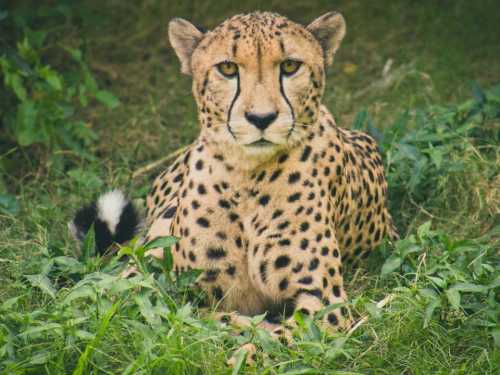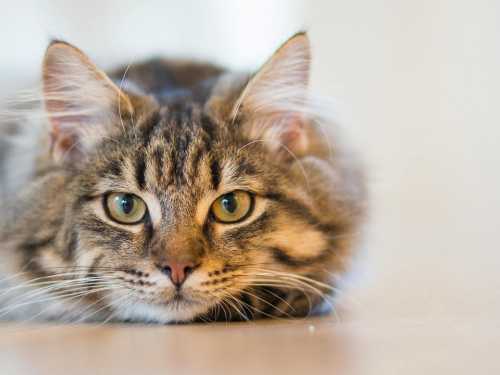
The current hero is unique in every way. It feels like nature tested a fundamentally new model of a living creature on him, but innovations are not so easy to implement, so the little animal was not launched into wide mass production. They left it with a narrow range, a limited edition, God forgive me, a collection with crazy technical characteristics. So, meet the cheetah.
“What about getting to know him?” you might say. “We had him at school. He’s a cat, he lives in Africa, he runs fast, he has stripes on his nose… Or are those stripes on a leopard?”
No, the cheetah really does have stripes – they are believed to help reduce glare from the sun, acting as natural “sunglasses”, in addition, the cheetah's body is covered in spots on its yellow skin, and it also has long, slender legs.
Now let's clarify which cheetah we are talking about? Today, some scientists still continue to argue about how many subspecies of these spotted beauties remain on Earth. There were quite a few, but we will return to that later. So, according to the latest genetic studies, scientists distinguish four subspecies: three of them live in Africa, and one is Asian. Although the classification was different before, the modern approach, based on genetics, is considered more accurate. The Asian cheetah, which has survived mainly in Iran, is somewhat smaller than its African relatives. Its fur is thicker — an adaptation to the cold winters on the Iranian plateau — although it retains the same graceful and slender physique. African cheetahs are distributed throughout various parts of Africa, although their range has been significantly reduced and fragmented, their numbers are inexorably declining, making their situation particularly difficult.
It's a natural secret that you can't just tell casual acquaintances. It just so happened that all living cheetahs are blood relatives. The last ice age led to a sharp decline in the cheetah population, leaving only a small number of individuals. This created a so-called “genetic bottleneck”, due to which the gene pool of the species never regained its former diversity. Because of this, the surviving cheetahs were forced to interbreed with each other, which led to a high level of inbreeding (closely related reproduction) in the entire population. As a result, their immunity is greatly weakened, which makes them vulnerable to disease. In addition, males have low sperm quality, and the mortality rate among kittens is very high. All this significantly reduces the species' ability to adapt to environmental changes. However, they still survive!
By the way, before this “bottleneck”, the range of cheetahs was much wider – they lived in vast territories of Africa, Asia, Europe and even North America. In Europe, for example, there lived a giant cheetah (Acinonyx pardinensis) – a separate extinct species, which was much larger than modern ones and reached a weight of up to 90 kilograms. You immediately felt the excitement of the prospect of meeting, didn’t you?
Our familiar cheetah weighs about 50 kg, its height is about 70-90 centimeters at the withers. It regulates the population of ungulates, such as impala antelopes, young wildebeest, and gazelles.
And here we come to the most interesting thing – namely, the structure of these incredible … cats? But cats or not? You might be surprised, but because of a number of “dog” features, zoologists of the past had a lot of disputes. Some features of the cheetah are so atypical for cats that they were jokingly called “cotops”. Wait, but it looks like a cat! Yeah. And it sits like a dog. But it climbs trees poorly (unlike most cats). And it retracts its claws only partially, unlike other cats, so they are always outward and help in running. And it runs like a dog, or rather – like a real greyhound. And the character of the cheetah is not cat-like, calm, and they are tamed in a moment or two, like … that's right, dogs. And genetically?! But it has been authoritatively proven that a cat is genetically. And the cheetah's closest relative in this regard is the puma, whose feline origin has never been doubted by anyone. So zoological creativity has sunk into oblivion under the inexorable authority of science, but, damn it, you look and involuntarily begin to doubt yourself… Well, Mother Nature had fun.
So, our cheetah runs like a greyhound (only several times faster – up to 110 km/h, although on average during hunting this speed is somewhat lower), because its legs are long, its lung capacity is huge, and its claws are non-retractable – they work like spiked sneakers. However, it can only run like that for a very short time – it doesn't catch up with its prey for the first thirty seconds – that's it, look for another one.
The thing is that such a sprint is a colossal anaerobic load. The body works at the limit, burning energy faster than oxygen can replenish it. Lactic acid instantly accumulates in the muscles, and the body temperature rises rapidly. To avoid complete exhaustion and heat stroke, the cheetah is forced to stop. But if it catches up, it knocks its prey off its feet, hooking it with its paw, and then quickly strangles it, digging into its throat, and immediately begins to eat. It eats as fast as it runs. Why? Because this spotted scavenger neglects carrion, and other predators – those that are smarter, excuse me, more unpretentious – know this. So the cheetah swallows pieces of its prey, practically without chewing, until it is taken away.
And now the cherry on the cake. Guess how these sprinters reproduce. Oh, they need space to “meet”! It’s all about their unusual social structure for cats: females are staunch loners who raise their offspring on their own, while males often unite in small groups-coalitions, usually from their own brothers. This helps them defend their territory and gain an advantage in the fight for the attention of females. So, for successful reproduction, they need large territories where their paths can cross, and courtship rituals, which include chasing and stalking, can occur naturally. That’s why captive reproduction is difficult – not every zoo can provide the necessary conditions to simulate this complex social dynamic.
Usually, the female gives birth to three to five kittens, which she carries for about 90 days, but honestly, if the parents are a little out of their minds, then the children too… In short, cheetahs have a camouflage gray coat on their back. The question is, why? Elementary – camouflage, so that all sorts of unkind birds of prey don't pull, well, or animals, but! There is a popular hypothesis that this “cloak” serves to disguise itself as a formidable honeyeater – an animal that even large predators prefer not to come into contact with. Kittens are mowed down under Honeyeaters for up to three months, and spend about 17-18 months next to their mother, learning to hunt, after which they begin an independent life.
Naturally, people could not pass by such a luxurious game-catching machine, so for a long time one of the cheetah's nicknames was “hunting leopard”. No, seriously, when you have a perfectly tame cat that can outsmart any hound, it's a sin not to use it. Therefore, cheetahs were hunted, tamed, caught and generally existed in close contact, until it became clear that if you don't mess around, then soon there will be no one to catch and tame. Now cheetahs are listed on the Red List of the International Union for Conservation of Nature as “Vulnerable”, and some subspecies, such as the Asian one, are on the verge of complete extinction. A dubious reason for pride, but this is their second chance: the first time they survived the ice age, and now their future depends on whether we can help them win the struggle for existence.





